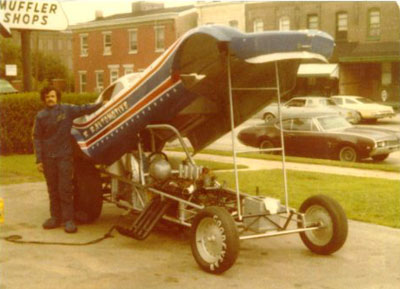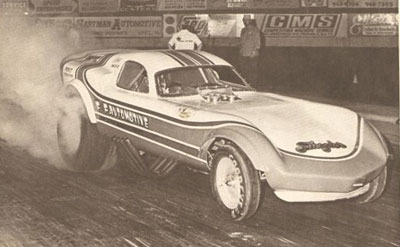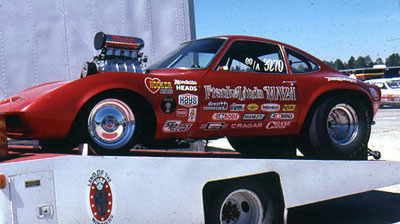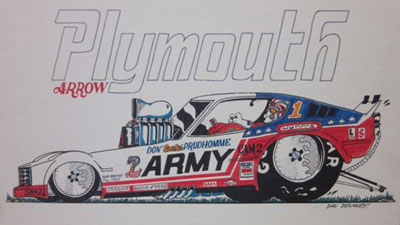

Cleaning out the e-mail, Part 2
Welcome back, and to Part 2 of my Inbox Blowout. On Tuesday, I began the daunting task of sweeping out the many Outlook folders I have created to handle the stream of e-mails from the faithful readers of this column and wanted some of the saved and unpublished ones to find light before I forget about them or before their subject is forgotten.
So here we go …
 |
 |
Nitro racing veteran Jim Murphy, who's still burning the cackle juice behind the wheel of a nostalgia Top Fueler nearly 40 years after his nitro Funny Car debut with the Holy Smokes 'Cuda, shared his introduction to the sport in an e-mail last year.
"It was late summer of 1971, and I was racing a blown fuel flat-bottom drag boat, which I had been doing for about six years," he wrote. "These boats were not the safest, and I had lost a number of friends during that period. Well, the final straw came in late summer of 1971 when a very close friend and former partner, Ted Holden, lost his life in a hydro. I made a decision at that moment to quit boat racing. Fast-forward to New Year's Day in 1972. I got a call from a friend, Ed Wills, who I had boat raced with, inviting me to Fremont to see what he was involved with. At that race, I saw and fell in love with Funny Cars. Ed was involved with Art Whipple, and he and his former partner Ed McCulloch were at the race that day. I was quite excited and had to get into this deal.
"As it turned out, Ed and Art had just built a new car, and the old car was for sale. I went to Fresno the day after the race and bought it. I knew a little bit about fuel motors as I had been running one for the last six years, but nothing like what I was about to embark upon. Art and Ed took me under their wing, and with their help, I ordered an engine from Keith Black.
"I spent the next three weeks getting all the other parts needed, having the car painted and lettered. I borrowed an open-wheel-stock-car trailer and planned to race at the Winternationals. I did not have a license yet, so Art and Ed suggested we contact a friend of theirs, Butch Maas, to drive because he had won the race the year before in Roland Leong’s car and, being the defending champion, was eligible for a guaranteed starting spot (that was the ruling at that time). I am thinking, 'We will at least get to race on race day and bring in a few dollars.' So we show up at Pomona with the open trailer (there were not any big rigs, but most trailers in this class were nice enclosed trailers). Lo and behold, we qualify No. 2 and have to race Roland in the first round. Long story short, we beat Roland’s car and lose to McCulloch in the second round. Ed goes on to win, and that was my start in drag racing, and here I am 30-plus years later still at it."
 |
Another pretty famous racing figure, former Top Fuel racer Johnny Abbott, sent me the photo above, the site of which is instantly recognizable to longtime SoCal fans and racers as the head of the staging lanes of good ol' Orange County Int’l Raceway, where the end of the pits rolled right into the head of the lanes, which then wrapped around the trademark starting-line tower. The main subject of the photo, taken at the 1981 NHRA World Finals, is Abbott's Jolly Rancher dragster, which had won Indy earlier that year, but Abbott was quick to point out something else about the photo. "The cool thing about this picture is you have the 1981 NHRA U.S. Nationals champion [and in the background] the 1981 NHRA Top Fuel world champion, 1981 91°µÍø Funny Car world champion, and 1981 91°µÍø Pro Stock world champion." Right he is, as you can see behind his car Jeb Allen's dragster, Raymond Beadle's Blue Max, and Lee Shepherd's Reher-Morrison-Shepherd Camaro. Pretty cool.
The event was memorable for Abbott as he not only was the No. 1 qualifier at 5.641 and had top speed at 247.93, but few remember that it was those numbers that Gary Beck famously had to exceed in the final round if he was going to steal the championship from under Allen's nose. Beck's final-round victory and 5.57 e.t. got him two-thirds of the way there, but his 245.23 fell a few mph short.
 Kevin Allgire of the Northeastern Indiana Racing Museum (Auburn) shot the photo at right of custom-car builder Carl Casper's Top Fuel dragsters while he was at the Kruse Horsepower Museum last summer while we were in the midst of our thread on streamlined dragsters. The car that got my attention was the one in the middle, between his Galloping Ghost entries -- the Cosmic Charger. It's a front-engine dragster with an enclosed cockpit and front-wheel pants. A poster that accompanies the display seems to indicate that the car ran 6.67 at 220.45 mph, but I can't ever remember seeing or hearing of this car, and I can’t find any records or photos of it running.
Kevin Allgire of the Northeastern Indiana Racing Museum (Auburn) shot the photo at right of custom-car builder Carl Casper's Top Fuel dragsters while he was at the Kruse Horsepower Museum last summer while we were in the midst of our thread on streamlined dragsters. The car that got my attention was the one in the middle, between his Galloping Ghost entries -- the Cosmic Charger. It's a front-engine dragster with an enclosed cockpit and front-wheel pants. A poster that accompanies the display seems to indicate that the car ran 6.67 at 220.45 mph, but I can't ever remember seeing or hearing of this car, and I can’t find any records or photos of it running.
 It took a lot of Web searching to find anything about it before I stumbled across the dragster in model-box form as a 1972 release by model maker MPC ("... a colorful Hemi-powered brute of an enclosed cockpit dragster. Racing bucket, roll cage, mag wheels, full covered body, 426 cid Hemi engine, scoop and blower, chute, front spoiler, hollow slicks, front bike tire, plated spoked wheels."). Casper has displayed his dragsters at his 40-plus-year-old Carl Casper Custom Car Show alongside his other memorable works, such as the 1965 America’s Most Beautiful Roadster, the (new) Batmobile, the A-Team vehicles, KITT from Knight Rider, and the General Lee from Dukes of Hazzard, so I'm wondering if the real-life car pictured here was built as a show car or if it actually ran. Anyone know?
It took a lot of Web searching to find anything about it before I stumbled across the dragster in model-box form as a 1972 release by model maker MPC ("... a colorful Hemi-powered brute of an enclosed cockpit dragster. Racing bucket, roll cage, mag wheels, full covered body, 426 cid Hemi engine, scoop and blower, chute, front spoiler, hollow slicks, front bike tire, plated spoked wheels."). Casper has displayed his dragsters at his 40-plus-year-old Carl Casper Custom Car Show alongside his other memorable works, such as the 1965 America’s Most Beautiful Roadster, the (new) Batmobile, the A-Team vehicles, KITT from Knight Rider, and the General Lee from Dukes of Hazzard, so I'm wondering if the real-life car pictured here was built as a show car or if it actually ran. Anyone know?
 |
In the same vein, reader Chuck Hodgkinson wrote last year to share his brush with greatness with a swoopy car. "Back in the mid-'60s, this wild and crazy guy, George Schreiber, spent the summer in Tumwater, Wash., with our neighbor Earl Poague. Earl drove AA/Gas dragster, and his dad, Terrell, was running Division 6 of the NHRA at the time. George was a heck of a cool guy, as was Earl. They treated all of us kids like kings. George was bigger than life, and along with Yellow Fang, they were hard to miss. Heck, this was an Ed Roth car. I think Earl had met George while racing in Australia. I think Tony Nancy was part of this group also. When we were kids, having a dragster push-start down the street and roll into Terrell’s driveway was normal. I think the Yellow Fang should be included with the streamlined and wedge conversation. I believe the picture was taken in Australia."
Speaking of rare birds, I heard many times throughout the last year from Jeff Foulk, who ran the Finagler Cougar injected fuel Funny Car and wanted to show me his long-forgotten follow-up: a GT40 Ford Le Mans-bodied entry.
 |
 |
 |
"I will wager just about any amount of money you have never seen this car before, at least not in its original ( '75 to '80) form unless you were a regular habitué of Englishtown or Maple Grove," he wrote.
"When my Finagler Cougar chassis was no longer legal, I wanted to stay in Funny Cars but do something different. I had long been intrigued by the idea of aerodynamic bodies, but being committed to small-block, injected nitro power, I was sort of adrift in the wilderness. Then came the original Pro Comp idea, which originally was supposed to be a 7.50 eliminator. Perfect! A/FC was included, and 7.50 e.t.s were definitely reachable with a light, small-block car. We were leafing through AutoWeek one day and spied an ad for Pepe's Fiberglas GT40 Ford bodies, which were being marketed to the sports-car crowd. The body came in pieces and did not have precut wheel housings, so it could be more readily adapted to different chassis. The original body was for a 90-inch wheelbase, but by moving the front and rear wheels, we stretched it to fit our 118-inch chassis. We glassed the doors in permanently, fitted the rocker panels, and with various other cobbling, came up with the body you see: a one-piece flip-top Funny Car.
"The body was extremely light. I could get under the roof and lift it by myself. The chassis was a Logghe wide cage but legal chrome moly that I bought from Charles Scott. Power was one of my homegrown Fords, a 351 Cleveland, which we increased to 366 inches, injected, on nitro. It was light (1,540 pounds), and the motor made loads of power. However, that is where the good times ended. That car was the biggest frustration of my life. No matter what we tried, I could not get the chassis to hook up. We put the biggest set of tires on it that would fit the chassis, but it could not be made to leave. The problem was that it had been converted to a solid mount rear, and I think it was just too light to plant the tires without any rear movement in the chassis. The end came when we finally got one good run out of it (7.82, 182 mph), but it ate the trans. We were still running the C-4 tranny, and now the only way forward seemed to be a clutch and a Lenco, and the motor was due for a new set of aluminum rods, none of which we had money for, so it got parked.
"After a couple of years, I got antsy and put my old 289/348 into the car just to screw around running alky. At the end of the '79 season, just one last time for old time's sake, I put it back on nitro. It weighed 1,470 pounds with the little motor in it, and all it would do was smoke the tires like a burnout! I sold the car to a kid with high ambitions and a lack of funds. Years later, it turned up on a used-car lot, where the present owner, Tim Hansberry, bought it. He is presently running it on the Nostalgia circuit. He had no idea of the car's origin until I ran an ad in ND trying to locate it. Because I always had viewed the car as unfinished business, I was interested in reacquiring it. The last thing Tim wanted to do was sell it. Probably just as well. It will always remain a thorn in my side. The potential was there. It was light, made power, handled great on the top end. The aerodynamics were perfect for as fast as I could ever have made it go. I know it would have easily been capable of mid-sevens. Of course, Pro Comp only remained a 7.50 eliminator for one race, so either way, I was up against it. The frustration is as fresh today as it was then."
 |
Where do old Funny Cars go to die? Apparently to England. British reader Pete Walton sent this photo of what he says is a former Don Schumacher Stardust flopper body.
"It has been let out into the sunlight for the first time in many, many years," he reported. "It's owned by Santa Pod Raceway and is supposed to be in perfect condition apart from the very bad paint job and even badder scoop. Not sure if they still have the chassis. I think it came to England in 1976-ish when Don came and did some racing." It's certainly not the first famous Funny Car to end up in Europe, as many of that continent's earliest floppers were recognizable as former greats on the NHRA circuit, but I never would have picked this one out.
 |
I also heard last summer from Roger Sinistri Jr., whose father was the engine builder for future Pro Stock great Larry Lombardo when he won the 1968 U.S. Nationals Stock title at the tender age of 19 in the F/Stock Buckshot '61 Corvette. Together, Lombardo and Sinistri Sr. won a lot of races and set the national record with this car, which Junior told me has recently been restored, as shown here.
Lombardo, of course, went on to great fame – under great scrutiny -- as Bill "Grumpy" Jenkins' Pro Stock pilot, replacing the legend in the seat of the Grumpy's Toy Chevys. Lombardo won six national events in Pro Stock – beginning at the 1974 Summernationals, an event he won three times. On a weird note, after he won the Summernats in 1977, he never won again despite appearing in seven more final rounds in the 1970s. What makes that factoid especially interesting is that in all seven of those unsuccessful final-round bids, he lost to the same guy: Bob Glidden. His last final round was, ironically, at the site of his first, Indianapolis, at the 1979 U.S. Nationals, where Glidden won his fourth of nine Indy titles.
 |
 |
 |
The video I posted of the Mazi family Opel drew a lot of oohs and aaahs, as apparently although a lot of you knew of the car, not many of you had actually seen (and heard) it run, so you got a new appreciation for it. And that was when the car was going straight (I'll never forget Frank's great advice before I drove the car for the first time, something along the lines of "The car has two positions: out of shape and about to get out of shape.").
Anyway, I found another e-mail from daughter Dawn that coincided with our ramp-truck discussion, showing their famous Opel up on the back of their hauler. She wrote, "The whole family (including Burn Out [their dog]) made the cross-country trip to the 1978 Winternationals in that single-cab hauler (the luggage was in the Opel), but for local events, all three of us girls would ride in the Opel. My dad was sponsored by Hy-Gain (a CB radio company) during the 1977 season, and so he installed a CB radio in the Opel and the truck so we could communicate with him in the hauler. It especially came in handy when we'd spot a Dairy Queen in the distance and wanted to stop because we were hot. Riding in the Opel to events gave us plenty of time to play 'race car.'
"We got a little carried away during one trip to Thompson when we unknowingly emptied the CO2 bottle while playing with the Lenco four-speed air shifter, taking turns popping the buttons through all gears and relishing the 'phtsshhhhh' sound it made. Our dad was quite surprised to discover an empty bottle when he warmed the car up in the pits that day. Thankfully, he had a spare bottle on hand. Good times!"
The final photo shows the two crashed Opel bodies (see what Frank meant?) -- the God of Hell Fire entry that was famously captured by Richard Brady tangling with the concrete Christmas Tree support at the SPORTSnationals and a second Opel that crashed in Norwalk -- being hauled away on a friend's ramp truck to the scrap yard. Sad times!
 |
Like many of us, reader Ed Eberlein doodled drag cars all over everything as a youngster, and some just never stopped, such as East Coast race car lettering ace Dan "the Sign Man" Delaney, who was inspired by the posting of Eberlein's art to send his early stuff. "I, too, was intrigued and inspired by the work of Youngblood and Nat Quick and the paint work at Kirby's. I just lived on the wrong coast, but we had our version of that Bellflower shop with Circus Custom Paint, Mr. "J," and Glen Weisgerber in New Jersey, still a very long bike ride from Buffalo, N.Y., where I grew up. I drew cartoons and pencil sketches of my local heroes and touring pros. I always wanted to letter race cars as a young kid. Playing with Hot Wheels like I'm sure most (all) of us did, building models, going to the drags. Well, attached are just some of my 'early' sketches. I sought out autographs, and I, too, was asked for copies of the drawings ... what a rush ! As you know, I turned my love of art into a lifetime career as a sign painter. Today, as I celebrate 35 years in the sign trade, I've lettered cars for some of my heroes from those early teen days and cherish the opportunities and friendships that have come from my business. I wouldn't trade it for the world!"
 John Bell, another artsy name familiar to many of you, also sent a few of his earliest works, including the Blue Max image at right. "I wanted to share some of what I was doing when I was 15," he wrote. "Back in '74, I had sold a painting to Don Schumacher at the PRO race for a whopping $30. Paid for some fine magazines and bubble gum. By the beginning of 1975, when I was 16, I had designed the paint scheme for Bill Leavitt's black and orange Quickie Too Mustang Funny Car. I saw Raymond Beadle at the CHRR this year, and I was astonished that he still remembered me (after almost 30 years) AND that he still had this painting! Throughout my teens, I was fortunate enough to design paint schemes and blue-sky ideas and sponsor renderings for drivers across the nation. Seeing Kenny Youngblood at the CHRR also reminded me how much he helped me develop my artistic skills. I'd write to ask how to make cars look shiny, how to get forms to read, etc. His letters would come back with detailed sketches! It blew me away. Anyhow, these are looking very crude today, but I was only 15 to 16 years old. It was better than going to work."
John Bell, another artsy name familiar to many of you, also sent a few of his earliest works, including the Blue Max image at right. "I wanted to share some of what I was doing when I was 15," he wrote. "Back in '74, I had sold a painting to Don Schumacher at the PRO race for a whopping $30. Paid for some fine magazines and bubble gum. By the beginning of 1975, when I was 16, I had designed the paint scheme for Bill Leavitt's black and orange Quickie Too Mustang Funny Car. I saw Raymond Beadle at the CHRR this year, and I was astonished that he still remembered me (after almost 30 years) AND that he still had this painting! Throughout my teens, I was fortunate enough to design paint schemes and blue-sky ideas and sponsor renderings for drivers across the nation. Seeing Kenny Youngblood at the CHRR also reminded me how much he helped me develop my artistic skills. I'd write to ask how to make cars look shiny, how to get forms to read, etc. His letters would come back with detailed sketches! It blew me away. Anyhow, these are looking very crude today, but I was only 15 to 16 years old. It was better than going to work."
 |
And finally, and still on the artwork front, there's this from Seattle's Al Kean, who shot the incredible photograph of Don Prudhomme's 'Cuda Funny Car on fire and flying through the lights at Seattle Int'l Raceway in the final round of the second annual Hot Wheels Northwest National Open in 1971.
Opined Kean, Ìý"I am sure you will be deluged by racers sharing their Christmas gifts (race cars, equipment, etc.), but mine was different, and fantastic! My wonderful wife and kids got an oil painting made of my well-known photo of Don Prudhomme's 1971 fire and flight in his 'Cuda Funny Car in Seattle. Pretty cool ! When I took this photo almost 40 years ago, I never thought that it would be a photo that would just keep giving for all these decades!"
OK, that's the majority of the stuff I've been holding on to, although there are still others (I have more than 20 subfolders, most of which I didn't delve into) that I may share in the future. I'm pretty happy with the stuff I unearthed just in the main Insider folder and feel that it was worth the time and effort to go back through scores of e-mails looking for the prime cuts. Thanks for reading.
Ìý




















































